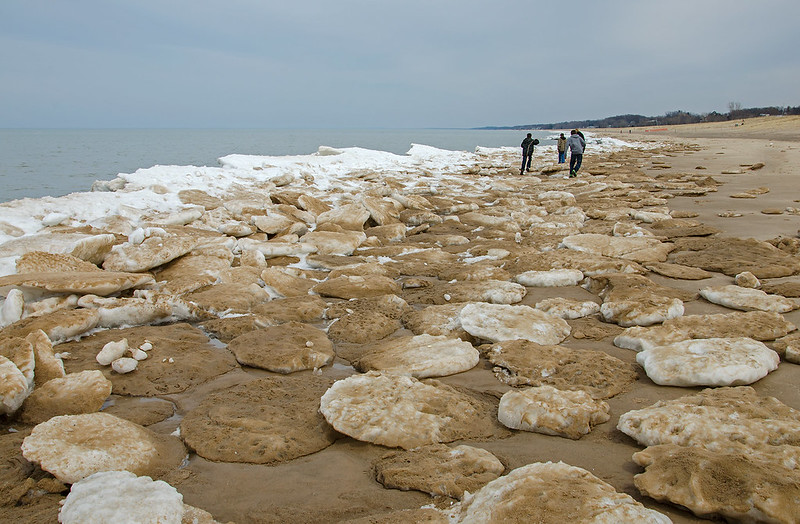 Following the break up of the ice on Lake Michigan, some of the drift ice made it back to shore with the help of some big waves. These chunks piled up on the beach in places, then new shelf ice formed at the shore. The chunks provided an interesting cobbled path to follow into the distance, and a great place for the kids to get some exercise. We wonderd exactly where each of these chunks were formed, where they spent the winter, and how long they were adrift before landfall. Perhaps they were local, perhaps they drifted from far northern Lake Michigan. Either way, the shore of Indiana was their final resting place.
Following the break up of the ice on Lake Michigan, some of the drift ice made it back to shore with the help of some big waves. These chunks piled up on the beach in places, then new shelf ice formed at the shore. The chunks provided an interesting cobbled path to follow into the distance, and a great place for the kids to get some exercise. We wonderd exactly where each of these chunks were formed, where they spent the winter, and how long they were adrift before landfall. Perhaps they were local, perhaps they drifted from far northern Lake Michigan. Either way, the shore of Indiana was their final resting place.
Cobbled Ice Path
 Following the break up of the ice on Lake Michigan, some of the drift ice made it back to shore with the help of some big waves. These chunks piled up on the beach in places, then new shelf ice formed at the shore. The chunks provided an interesting cobbled path to follow into the distance, and a great place for the kids to get some exercise. We wonderd exactly where each of these chunks were formed, where they spent the winter, and how long they were adrift before landfall. Perhaps they were local, perhaps they drifted from far northern Lake Michigan. Either way, the shore of Indiana was their final resting place.
Following the break up of the ice on Lake Michigan, some of the drift ice made it back to shore with the help of some big waves. These chunks piled up on the beach in places, then new shelf ice formed at the shore. The chunks provided an interesting cobbled path to follow into the distance, and a great place for the kids to get some exercise. We wonderd exactly where each of these chunks were formed, where they spent the winter, and how long they were adrift before landfall. Perhaps they were local, perhaps they drifted from far northern Lake Michigan. Either way, the shore of Indiana was their final resting place.
Remnants of Winter
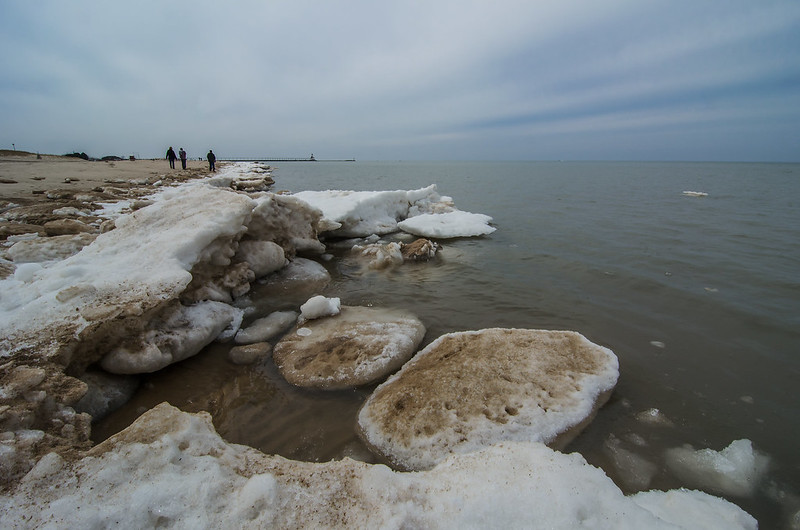 The almost endless shelf ice mounds have all but disappeared, and liquid Lake Michigan is once again a reality. This winter hid that water under ice as far as the eye could see. Walking northeast along Washington Park Beach in Michigan City, Indiana, we encountered the last bit of shelf ice. The ice extended the length of the shore to the horizon, could this have been the southern extent of the ice that day? No more ice south, only north? It's possible. This little remnant of winter gave us the unusual opportunity to safely investigate the shelf ice up close. It was safe since the water was only about a foot deep at the end! It was still dramatic, and interesting to see the formations, as well as the physics behind pancake ice. The small waves pushed floating ice against some recesses in the shelf ice, so the ice would hit and spin, hit and spin, rounding the edges to form "pancakes." I'm pretty sure this is all but a memory now.....four days later.
The almost endless shelf ice mounds have all but disappeared, and liquid Lake Michigan is once again a reality. This winter hid that water under ice as far as the eye could see. Walking northeast along Washington Park Beach in Michigan City, Indiana, we encountered the last bit of shelf ice. The ice extended the length of the shore to the horizon, could this have been the southern extent of the ice that day? No more ice south, only north? It's possible. This little remnant of winter gave us the unusual opportunity to safely investigate the shelf ice up close. It was safe since the water was only about a foot deep at the end! It was still dramatic, and interesting to see the formations, as well as the physics behind pancake ice. The small waves pushed floating ice against some recesses in the shelf ice, so the ice would hit and spin, hit and spin, rounding the edges to form "pancakes." I'm pretty sure this is all but a memory now.....four days later.
A Challenge for Top Bird
 Standing on the last bits of shelf ice along the shore of Lake Michigan, these seagulls loudly challenge one another for the spot of top bird. Most of the Indiana Dunes National Lakeshore shelf ice has melted completely, but a rather large area of Washington Park Beach remained frozen. Possibly the southern extent of the ice at this time? Perhaps, but at any rate, it made for a very interesting walk on the beach today. The area is looking a lot more like Spring now, with wildlife awakening, sand visible, boats on Lake Michigan, and bulldozers replacing the sand blown into the parking lot over the winter. Soon, the beach will swarm with sunbathers and swimmers; can't wait.
Standing on the last bits of shelf ice along the shore of Lake Michigan, these seagulls loudly challenge one another for the spot of top bird. Most of the Indiana Dunes National Lakeshore shelf ice has melted completely, but a rather large area of Washington Park Beach remained frozen. Possibly the southern extent of the ice at this time? Perhaps, but at any rate, it made for a very interesting walk on the beach today. The area is looking a lot more like Spring now, with wildlife awakening, sand visible, boats on Lake Michigan, and bulldozers replacing the sand blown into the parking lot over the winter. Soon, the beach will swarm with sunbathers and swimmers; can't wait.
The Last Grip
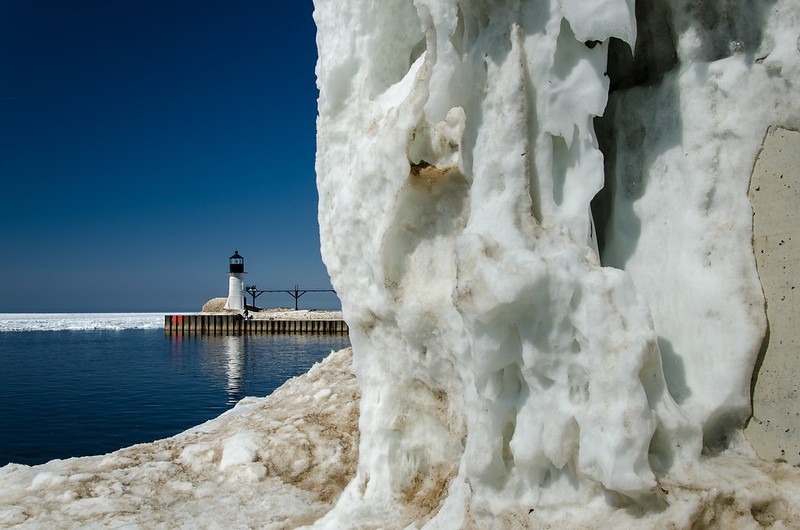
Probably the last of winter's grip on the St. Joseph, Michigan lighthouses and channel markers. Over the winter, ice built up on the concrete piers marking the banks of St. Joseph River - in places, feet thick. The increasingly sunny days bring with them warmth and the ability to melt this coating, once again revealing the structures underneath.
The piers were lined with fishermen, the shore dotted with seagulls and eager beach-goers, and the lake with melting drift ice. Warmer weather, and storms this week will almost certainly eliminate the last of winter's creations.
The Melting
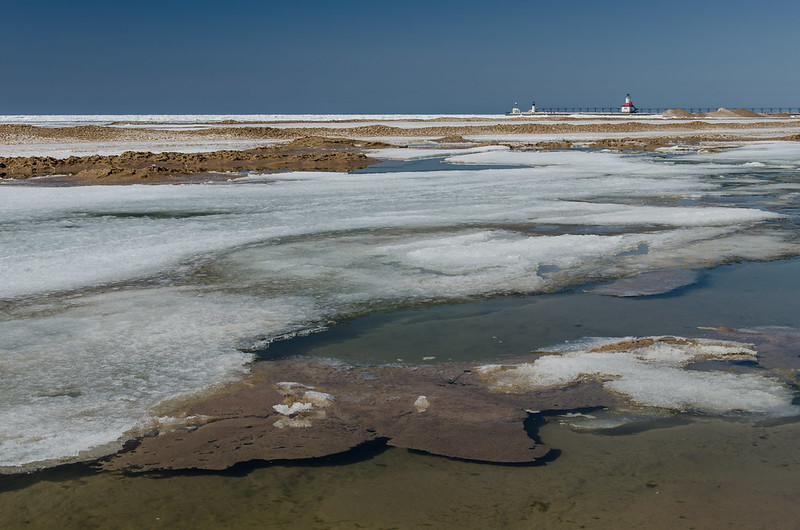
Winter finally begins to release its grip on Lake Michigan, as the ice begins to melt. Still extending to the visible horizon, the ice is giving way to a bit of water, creating some interesting formations along the shore.
Full sun, and temperatures reaching 50 degrees Fahrenheit made the walk on the beach comfortable - after 4 months of dashing through frigid weather. The St. Joseph, Michigan pier was swarming with people, walking, biking, and fishing; probably the first outings for most this year. It felt great to walk in sand again, rather than ice and snow.
Icy Expanse
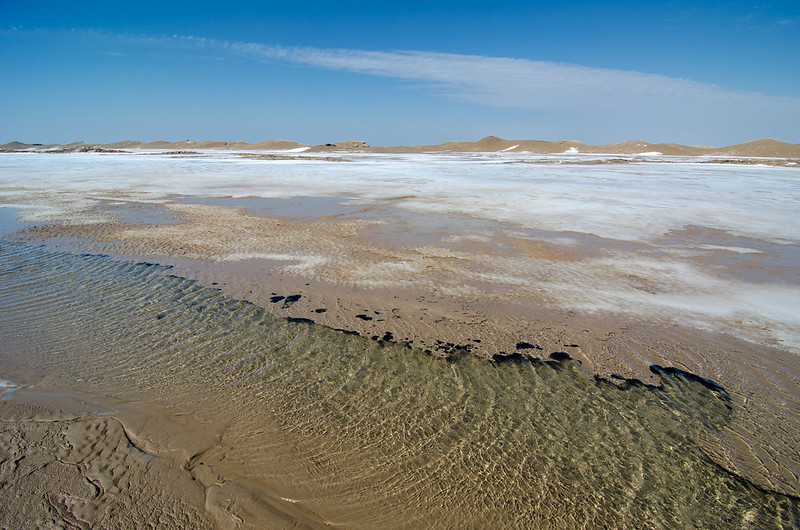
Looking more like a scene from the Great Salt Lake, or a volcanic vent, the shore of Lake Michigan is in a thawing state. The mounds of shelf ice a few hundred feet off shore appear like mountains in the distance, while the melting ice at the shore has the look of mineral deposits, with jagged edges leading to cavernous spaces beneath the water.
The melting ice near the shore created some beautiful patterns on the edges; looking rather delicate, it could support my weight. This melting just began, and we only noticed it in a small area of the beach. Each day, will change this "landscape" drastically, until the ice is gone.
As cold as the water was, I felt the need to wade in just to experience the floating ice highlighted by the sun and shadows. Ultimately, I resisted. I do, however, wish to bring along a kayak next time, to paddle in the water next to and between the mounds of ice.
Dune Patterns
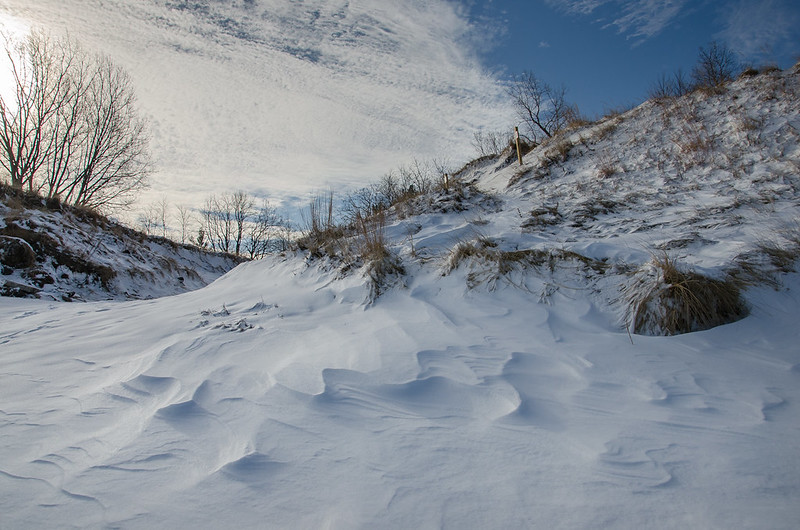
Partially obscured by high clouds, and the dunes, the early morning sun highlights the wind-blown patterns in the freshly fallen snow. Our first steps onto the beach after walking a few miles from the nearest parking area, and between these two dunes, were into the thigh-deep snow. Solid in places, we'd fall through every few steps, making the hike a bit of a chore.
We walked as fast as possible to get to a legal place to climb the dunes before the distant clouds rolled in. As it turned out, after a long while on the top of the ridge, the clouds disappeared for the rest of the day, making the waters of Lake Michigan deep blue, and the drift ice bright white.
Horizontal Bands
The deep blue waters of Lake Michigan, drift ice, shelf ice, sand, and snow create interesting bands of color and texture along the beach. A relatively warm day allowed some of the ice on the lake to melt, a sure sign of Spring. The snow will disappear soon as well, but the 15 foot tall mounds of shelf ice can take weeks to melt.
As much as I dislike cold weather, winter is a magical time on the Great Lakes. After hiking miles to reach locations for photographs, I often remain, soaking in the atmosphere - quiet solitude. I'm almost always the only person in sight, and from some vantage points, I can see for miles.
Once summer arrives, I'm rarely the only person in sight - unless I seek some of the relatively unknown places at the Indiana Dunes National Lakeshore, which I often do.
The Break Up, From the Ridge
This winter, most of the lakefront access areas I frequent, were closed, preventing me from viewing the frozen lake. The main issue with the closings, was parking- there was nowhere close to park. Having been to these beaches every winter for years, I was determined not to break the streak, so we found the nearest parking area, and hiked in about three miles one way.
It was a relatively warm morning, with stiff winds blowing in, and fading sunshine. We managed to climb the snow covered dune safely (and legally), and were greeted by this view.
Previously, ice covered Lake Michigan as far as the eye could see, but with the recent warm temperatures and high winds, the ice began to break up. The shelf ice, however, isn't going anywhere for some time. From approximately 80 feet above the beach, we could see the extent of the 15 to 20 foot tall shelf ice mounds, and the deep blue, open water.
Well worth the hike and the climb, we experienced the beach in winter - one of my favorite times to visit - with no other people in sight for miles. After capturing photographs, we remained on the ridge for some time, just to soak in the experience.
On to the next place, it was only 8:00 am....
Inside the Sugar Shack
The historic boiler inside the Chelberg sugar shack is wood fueled. A worker quickly opened the doors to add another log to keep the sap boiling. After a moment, he closed the doors and a sound very similar to a jet engine emanated from the boiler, as the oxygen was sucked in from other places. The heat and steam generated by this process makes this cold weather work, rather comfortable, if you don't mind a bit of rain dripping on your head from the condensed steam.
Maple Sugar Time
Following a winter with plenty of days below zero, the sap isn't quite ready to run. Days need to be above freezing, and nights need to dip below freezing for the sap to start running enough to collect. We have had a few days above freezing, so the staff and volunteers at the Indiana Dunes National Lakeshore were able to collect a bit of sap for Maple Sugar Days, two weekends of Maple sugaring demonstrations.
The sugar shack houses a wood fired evaporator to boil off the majority of the water from the maple sap. With the cold weather, the sugar shack is the most comfortable portion of the maple sugaring process, inside a building with a large fire burning, and plenty of steam. So much steam, in fact, that it "rains" inside the building as the steam hits the cold steel roof, and condensates.
Structure Revealed
Ice "Locked"
As Far As the Eye Can See
The Michigan City East Pierhead is locked in ice - ice that extends as far as the eye can see, and covers over 60 percent of the surface of Lake Michigan. While this ice seems solid, it's made up of chunks of drift ice, pushed by the wind into the shelf ice on shore. Snow and more ice filled in the gaps between the chunks, forming what appears to be a solid slab.
The Indiana Dunes National Lakeshore can be seen on the horizon at the left of the image. Locked in by mounds of ice on one side, and closed parking lot gates on the other, waiting for spring and thousands of visitors. I prefer visiting in winter, when I'm usually the only person in sight, and the views are ever changing.
Indiana Dunes Shelf Ice
The sand dunes of the Indiana Dunes National Lakeshore seen from far offshore, beyond the shelf ice that lines the beach. The space between the mounds of ice in the foreground, and the 125 foot tall sand dunes in the distance is Lake Michigan - frozen solid with shelf ice, and drift ice. This winter, over 60 percent of Lake Michigan is covered in ice, and liquid water cannot be seen anywhere between shore and the horizon.
If you view this image full size, the ice along the shore is clearly visible; mounded up by waves crashing in to the shore several weeks ago. This provides an example of the extent of the ice.
While this ice appear solid, it's actually floating on the surface of the lake, and moving slowly. Extremely dangerous to walk on, the temptation is far too great for the people who ignore the danger signs and venture out onto the ice - a potentially deadly undertaking.
I was in a safe location while taking this photo, not on the shelf ice.
Bright Snowcovered Lake
Following a day of light snow, and weeks of below average temperatures, the ice on Lake Michigan is not only bright white, it's covering over 60 percent of the lake - more than we've seen in decades. The sun made the 16 degree temperatures seem warm, as we made our way through knee high snow to the pier. Once on the pier, we made certain to stay on the actual pier, and not walk on the thick shelf ice that was mounded next to and on to the pier.
The trek out was fairly easy considering all of the ice, but toward the end of the pier, as I made my way around the lighthouse, the surface was very slippery, and the mounds didn't make it any easier to stay upright either.
Going out onto the pier in winter, gives you a great view of the shelf ice - from off shore. Photographs of that, coming soon.
Colored Ice
As water flows over and through the sandstone canyon walls, it picks up minerals and particles, and deposits them on the canyon floor. In winter, the minerals and particles freeze in the ice, creating interesting earthtone colored ice that matches the canyon walls.
The colored ice was almost disorienting in some places, as the perfectly smooth colored ice made people and items appear to float above the surface, as well as reflect the canyon walls. Certainly an interesting thing to experience first hand.
Beyond Cedar Point
Beyond Cedar Point lies a short, blind canyon containing two waterfalls each approximately 20 feet in height. In winter, the waterfalls freeze, often creating caves of ice between the frozen waterfall and the canyon walls. It's great fun exploring these caves; they evolve everyday, and are rarely the same two visits in a row.
Often very slippery to climb into, but well worth the effort; it's as if you're transported to the underworld when inside. Visually similar to rock caves, the ice formations take only a fraction of the time to create as their stone counterparts.
The light penetrates the ice walls, creating mesmerizing works of art from floor to ceiling. Minerals, sand and soil intermix with the ice, resulting in varying colors of ice.
Cascading Ice
Lake Falls, a 30 - 40 foot tall waterfall, froze solid this winter following a string of cold spells, some down to 17 below zero Fahrenheit. Because of the spray from the falling water, it's often very difficult to photograph so close to this waterfall, but when it's frozen, it's not a problem.
Actuallly, the water is still flowing behind the ice. The intricate formations create a type of "ice pipeline," allowing the water to flow within. As you approach the frozen falls, you can often hear the flowing water, and on this day, we heard the water making a squeaking sound behind the ice.
Unlike most of the other waterfalls in the area, this particular fall does not create large ice caves behind it. More on those in the coming days.
The Ascent
Generally a waterfall cascading 30 to 40 feet to the bottom of the canyon, this year's harsh winter has stopped it in it's tracks. While completely frozen on the outside, water continues to fall behind this wall of ice. Upon arrival, we could hear the water rushing inside, and as we got closer, we could see it through the holes in the ice.
We hiked through the canyon for about three hours- in 15 degree temperatures, stopping to view over six frozen waterfalls of different sizes. With the recent snowfall, many of the ice formations were covered, and not as impressive as past years. In many places, we could hear and see the water of the stream flowing beneath our path - the frozen stream.
We'll head back in the next couple of weeks, to check on the progress of the frozen falls elsewhere in the area.
Subscribe to:
Comments (Atom)

